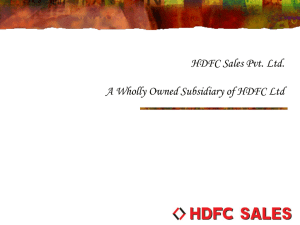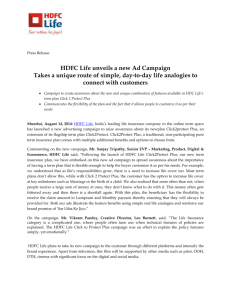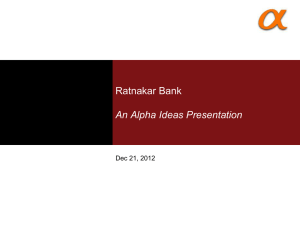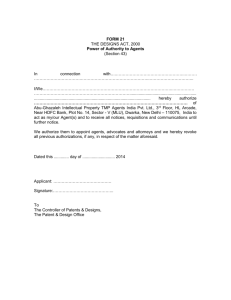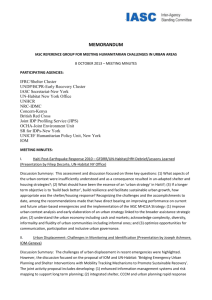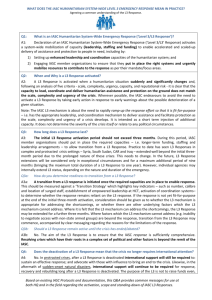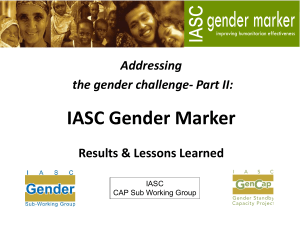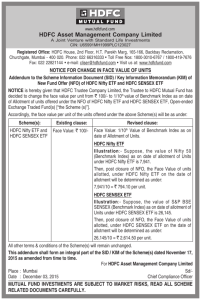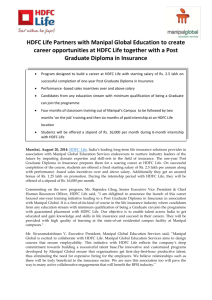Indian Association for Savings and Credit
advertisement
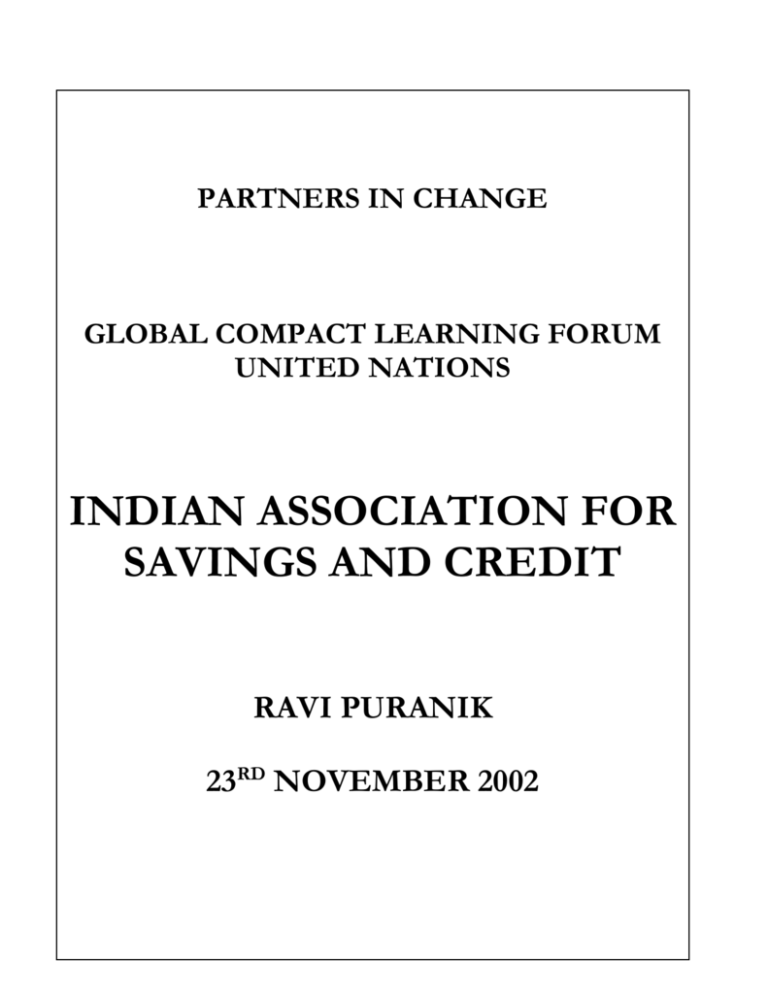
I PARTNERS IN CHANGE GLOBAL COMPACT LEARNING FORUM UNITED NATIONS INDIAN ASSOCIATION FOR SAVINGS AND CREDIT RAVI PURANIK 23RD NOVEMBER 2002 1 INDIAN ASSOCIATION FOR SAVINGS AND CREDIT (Case of micro finance institution with corporate and NGO equity in India) Abstract: The subject of this case is the Housing Development Finance Corporation Limited, (HDFC – www.hdfc.com a leading Housing Finance company in India).The objective of the case is to document its engagement with Palmyrah Workers Development Society (PWDS- www.pwds.org a leading Non Governmental Organization - NGO in South India) to shape a replicable response to the problem of access to formal credit for housing and livelihood needs of the poorer sections of society in India. Home ownership and access to credit are human rights issues for any society. This case presents an experience located in the Indian context where a housing shortage of 26.5 million units in rural areas and 14.3 million units in urban areas by the year 2001 was projected by the 8 th National five year plan (volume 2). It studies the evolution of a profit making (without distribution) company (named as Indian Association for Savings and Credit – IASC), jointly promoted by HDFC and PWDS as a response to addressing this need. More specifically, the study looks at the origins of HDFC’s involvement in this effort, the continuity of this involvement for more than a decade. It also traces the impact both internally (within the company) and externally (on communities) and raises outstanding issues for the future. It is advised by perceptions of key actors as also the available literature the narration primarily adopts a chronological style and sacrifices this in exceptional cases for the sake of thematic continuity Case: “HDFC has always played a leading role in an effort to build a consensus with players in the housing industry, with non profit organizations, and with leaders at every level of the government to develop a plan to boost home ownership in India. We will forge new partnerships by fostering creativity, sharing ideas and exchanging information. By promoting strong leadership, and ensuring focus, continuity and accountability, we communicate the genuineness of the public private partnership. Our strategy consists of identifying a series of concerted actions to help middle and low income families overcome current barriers to owning a home – actions to be undertaken by central, state and local governments, in cooperation with private industry, national not profit organizations and community groups. Working as partners in this way, we can translate synergy into achievement, making the dream of home ownership a reality for millions of hard-working people and building a better future for all Indians. The governance structure that will enable this national partnership needs to be based not only on legally binding agreements but also on the corporate conscience of each partner” - Statement by, Mr. Deepak .S. Parekh, Chairman in Annual Report 99/00 The Board of Indian Association for Savings and Credit (IASC) is meeting on the 24th October 2002 in Mumbai. Mr. Harish Khare (Harish) and Mr. Uday Shankar (Uday) are discussing the agenda. Harish is a finance professional working as Assistant Manager with the – Development Finance Cell of HDFC. He joined HDFC in 1999 and has been involved in the evolution of its micro finance portfolio, including associating with NGOs. Uday is a Post Graduate in Agriculture Economics .He had served as a Rural Development Officer and as Assistant Manager with the Syndicate Bank ( a major formal bank in South India) , working most of his career in the backward rural areas of Kerala, Karnataka and Tamil Nadu. He resigned from this job to join IASC as its Chief Executive Officer in September 1998. Both have just emerged from a sub-committee meeting at Chennai (Madras), which had met to chalk out a future structural form for IASC. One of the major reasons for this was that securing funds for on lending to community groups was becoming an issue for IASC. Somewhere along the line HDFC had also undergone similar pangs in its earlier life. So the parental concern was but natural. TRACKING HDFC HDFC was promoted as a development finance institution to bridge the gap of institutional finance in the field of housing. It was promoted by Industrial Credit and Investment Corporation of India (ICICI), International Finance Corporation and His Royal Highness the Aga Khan in 1977. An indication of its vision can be had from its visualization of ‘housing’ and ‘finance’ in the company staff hand-book, which read as follows 2 “Housing: A house is the visible symbol of a family’s identity, the most important material possession a man can ever have the enduring witness to his existence, its absence, one of the most potent causes of dissatisfaction, and conversely, its possession one of the most effective guarantees of social stability. Finance: Finance is an all-important part of the house acquiring process”. HDFC thus sees housing as a barometer of social stability. As mentioned by the Chairman in the company annual report (87-88), the setting up of HDFC was born out of the appreciation that a specialized institution was needed to channel Household savings as well as funds from the capital market into the housing sector. HDFC’s achievements over the years is summarized in its Chairman’s observation in Annual Report (01-02) “As HDFC turned the century, it had created a network of institutions providing a variety of financial services for retail customers. Housing finance services were being broad based through a series of separate institutions providing Banking, Real Estate services, a Mutual Fund, Life Insurance, IT enabled services, Stock Market related services, a retail credit rating initiative- a Credit Information Bureau and more recently General Insurance. The brand became a household name known for professionalism, service and quality throughout India. Today HDFC covers the entire country with 118 offices, cumulative approvals and disbursements of over Rs.400, 000 million (US $ 8333 million) and Rs. 335,000 million (US$ 6979 million) respectively and Total assets of Rs. 214,590 million (US$ 44700. HDFC’s none performing assets after twenty five years of operations remains a mere 0.91% - one of the best records of any financial institution anywhere in the world despite a difficult contractual system in the country”. HDFC AND THE POOR “India’s poor millions need a shelter and minimum basic facilities. Many agencies such as the housing boards are performing the tasks of building, repairing and financing various types of housing. Yet it is obvious that our total effort is not commensurate with our massive requirements. Government by itself cannot cope with the magnitude of the problem, nor can private efforts alone suffice. It is the community’s problem requiring coordinated effort with the government’s assistance.” - Statement by Mr. H.T.Parekh Chairman, HDFC (77-93) A Charity approach- Shelter Assistance Reserve HDFC’s work with the poor started in 1987-88 through the Shelter Assistance Reserve (formerly called the Shelter Assistance Fund). The Reserve was to be used to support meaningful development projects (on a charity mode) outside the scope of HDFC’s normal activities... The funds available from this Reserve were utilized to make grants to NGOs, community based organizations, and public institutions across the country covering a diverse range of social causes. The reserve was capitalized from the annual profits of HDFC, which would accumulate over time. The corpus of the Reserve stood at Rs. 95.7 million (US$ 1.99 million) as of 31st March 02. A Commercial Approach Kreditanstalt fur Wiederaufbau (KfW) In order to expand its business with the low-income communities, HDFC accessed the low interest Financial Cooperation funds from KfW, a German Development Bank in 1989. This line was specifically intended for the economically weaker sections (EWS- family incomes below the equivalent of DEM 90/ month as defined in the Fifth Evaluation Report on Projects and Programmes Promoted in Developing countries) in India for onward lending to the target communities in the form of housing loans. HDFC discovered that the intended outreach could not be achieved through the granting of loans alone. The client scatter and issues pertaining to loan documentation and such other factors made it difficult for the network of HDFC offices and outreach facilities to reach and then follow up on disbursement and repayments with such clients. They needed to be supplemented with institutional mechanisms closer to the low- income communities. HDFC therefore ventured an innovative path by engaging with NGOs. The understanding was that the NGOs would help in selection of and assistance to the clients and also bear the responsibility of recovering these loans and make timely repayments to HDFC.The experience of working with NGOs through the Shelter Assistance Reserve helped HDFC in activating the KfW portfolio in the initial years. The mechanism was essentially that a project would get sanctioned to an NGO based on a proposal that the NGO put 3 forth to HDFC. This would be then refined and developed with considerable inputs from HDFC. The funds would then be disbursed to the NGO who in turn would retail them. This mechanism apparently worked well as the KfW evaluation report (carried out in 1996/ 1997) rated it with a performance rating of 1 “Very good and good development results”. Palmyrah Workers Development Society (PWDS) was one such NGO, which approached HDFC in the late eighties and secured the first loan in 1990 TRACKING PWDS PWDS was formed in 1977 to address the cause of “Palmyrah” workers in five blocks of the Kanyakumari district and Thiruvananthapuram district (Neyyatinkara block) located in the peninsular South Indian states of Tamil Nadu and Kerala respectively. The vision building process at PWDS can be ascertained from the following “Visions are not created or worked out, but received. This is a vision received by a group of friends that reveals it and realizes its aspirations over the decades. Compassionate charity, conscientised solidarity, self reliant communities and the resulting liberation, freedom and augmented quality of life were the limited goals at each stage of realizing the vision” Between 1977 and 1986, a strong social movement had been catalyzed by the PWDS with support from Evangelische Zentralstelle fur Entwicklungshilfe e V (EZE, headquartered in Bonn, Germany) among over 19000 Palmyrah workers. The workers were organized into village groups called Mantrams, which then articulated the voice of its members. Many of the workers’ demands such as Accident insurance, Minimum Price fixation for Jaggery (A sweet product got by processing Palmyrah), Reducing Police Harassment, and Loans for Jaggery making from the Banks had been successfully realized. PWDS AND HOUSING The workers were moving up the economic ladder and the aspiration was now for improved and pucca housing. Apart from the fact that the processing operations for jaggery was a part of the traditional housing (and in that sense it was both a production asset and a place to stay) layout, the workers saw it as a definitive status symbol to move up the social chain. These signals were captured by the field staff at PWDS and transmitted to its leadership. Housing had been on the agenda of PWDS even earlier, though for different reasons. The thatched houses were prone to accidents while neera (juicy content from the Palmyrah fruit) was boiled and hence a solution was needed. Also the local economy would benefit due to construction activity. A proposal on housing was submitted to EZE in 1986, which incidentally was also the year when Mr. Reji Chandra (Reji) got intensively associated with PWDS, while it was undergoing an evaluation by the EZE. He was then a member of the “communication” faculty at The Theological College, Madurai. The Housing proposal had a credit component, which had to be mobilized from mainstream credit organizations. It is in this context that Reji initiated communication with HDFC after he quit the college and joined PWDS in 1988. PWDS AND HDFC The early days The convergence took place when HDFC was looking for NGOs that could take on retail housing finance on its traditional terms and conditions and PWDS was looking at credit for their community. Hence the basis for a formal association was already there. PWDS claims mention as one of the earliest NGO borrowers from HDFC. It started off as a letter by Reji to the headquarters of HDFC in Mumbai. The deepening dialogue The Deepening Dialogue - HDFC and NGOs As mentioned in the Results of Financial Cooperation, Fifth Evaluation Report on Projects and Programmes in Developing Countries by KFW, some NGOs criticized the relatively high demands placed by HDFC on individual projects as reflecting a “conservative” attitude. This might have contributed to HDFC exploring alternatives to outreach housing credit to the low income groups. It also set the agenda for a series of discussions between PWDS and HDFC .These discussions included the various problems related to housing finance for the poor, the 4 limitations and potentials of NGOs and formal financial institutions and the need for alternate , self sustainable delivery systems to reach the poor. The Coalition of Housing Finance Institutions provided a forum for this by supporting a consultation on “Partnership in Expanding Access to Housing Finance” on October 14-15, 1991, at the Centre for Housing Finance (an HDFC training facility), Lonavala in the state of Maharashtra. Mr.Nasser Munjee (Nasser), then Executive Director of HDFC responsible for mobilizing resources for retail lending operations, was present there as were around 20 participants representing NGOs involved in shelter programmes. Here, the need for a systemic solution to the issue of housing credit was reiterated. Thus in a way, the forum echoed Reji’s view that, “A development NGO should not become a rural branch of a finance institution or convert itself into a finance institution. Lending is the business of a finance institution, not of a development organization”. Nasser and his colleagues at HDFC were thus confronted with the problem to shape a sustainable delivery strategy that would disseminate housing credit to the poor in an efficient and effective way. What was clear to all present in this meeting however was that such a strategy had to have a blend of the corporate and NGO expertise? To set this in motion, it was decided to develop partnership models based on two experiences, one in the urban and other in the rural context. This decision followed HDFC’s way of “learning by doing”- an enduring work culture of the organization as articulated by the Chairman in the Annual Report of 2001-02). PWDS was to look at the rural areas. This event also saw the beginning of an eventful association between Nasser and Reji. Nasser, a trained economist hails from a family that traditionally has been active in community development. His entry into HDFC was more or less co-terminus with His Highness the Aga Khan getting interested in HDFC. He has been involved in community development pursuits himself like chairing the Aga Khan Rural Support Programme (India), among others. At the leadership level he also articulated HDFC’s involvement with weaker sections by being associated with the company’s other pursuits such as the formation of Gujarat Rural Housing (GRUH) Finance Ltd... The personal touch that these professionals brought in to this organizational relationship arguably was the cause of many developments as the future unfolded. For HDFC this relationship straight away provided staff at all levels an access into the NGO way of doing things. Origins of the institution The models evolved by PWDS along with HDFC were presented at the Consultation in Manila, Phillipines between 25 and 27 Jan 1992. This consultation was attended by Nasser and Mr. Deepak Parekh (then Managing Director, HDFC). The creation of an alternate financial institution appeared to be the preferred approach as it tied with the overall HDFC approach of setting up specialized institutionsi. This was followed by interactions at the community level by PWDS to gauge their readiness for such a venture in and around Marthandam where the PWDS operations were based. Deepening dialogue – PWDS, Palmyrah community, EZE, HDFC and others EZE, in order to strategize its involvement in housing for the poor in India, sponsored a Workshop which was conducted in Feb 93. HDFC participated in this workshop which also saw the involvement of several professionals from the housing development industry, donors and NGOs. PWDS also participated.This is where the churning on HDFC’s involvement in the alternate financial institution began to take shape. The target customer segments of HDFC in its regular lending operations were the middle and high income group’sii.HDFC was therefore gearing for a larger involvement in financing the low-income and poorer sections of society. INSTITUTION TAKES FORM Action plan Late in 1994, the Development Association for Savings and Credit (DASC) Project Report was drafted. The report laid down the action plan for setting up and operating the proposed alternate financial institution. It essentially projected HDFC’s belief outlined by its Chairman in its Annual Report 94-95: “Concept of specialized personnel for different functions retains the benefit to be derived from comparative advantage” 5 Development Association for Savings and Credit (DASC) report by PWDS DASC emerged to address the issue of providing better access to housing finance and economic loans for the participating community in the project area. The concept of DASC was built against the tide of the then contemporary majority thought and on the strength of the village mantrams (groups) which are the mainstay of PWDS programmes. This report became the basis for giving shape to what eventually would become the Indian Association for Savings and Credit (IASC). Upgrading Understanding of key processes The report underscored the understanding within HDFC that credit for housing had to run parallel with loans for economic purposes in most cases. This opened up HDFC’s quest for understanding the microfinance sector which was then shaping up, both in India and globally. HDFC had to contend with developing the strategic understanding of Micro finance within HDFC and then align this with the proposed DASC, apart from managing the relation with PWDS. HDFC’s forays into Micro Finance led to its appointment by the United States Agency for International Development (USAID) and National Housing Bank (NHB) to lead a team of microfinance and housing finance professionals for an orientation visit to Grameen Bank in Bangladesh and banks in Indonesia including Bank Rakyat Indonesia and Bank Dagang Bali. HDFC in collaboration with USAID and NHB conducted a workshop on micro finance which was attended by several Community Based Financial Institutions. HDFC also compiled a source book on micro finance which included best practices and case studies from different regions of the country. A Concept Paper on Micro finance institutions in Indiaiii was generated internally at HDFC. The paper concluded the necessity for an Intermediary to reach credit to the poor and broadcasted “DASC” as an alternative among the Micro Finance practitioners. The intent was to initiate a debate and get views from various quarters to further reinforce the strategic insights within HDFC. The international focus on eradication of poverty, the involvement of various stakeholders in providing financial services to the poor and taking micro credit under the fold of Human Rights provided the enabling environment in which this understanding evolved Securing a structural form for DASC With this understanding HDFC initiated the process of structuring the intermediary. As an official of the company involved in this process recollected, Nasser briefed him thus about the nature of the proposed entity; “I want an Institution operating at a National Level for channelising funds from the formal to the informal sector. DASC could either play this role or could be used as a successful model for this purpose”. According to Reji, the models available in India at that time were NGO promoted Micro Finance Institutions (MFIs), NGOs converted to MFIs or NGOs federating community groups into MFIs. The response being proposed in the form of DASC was an MFI with equal equity participation by both the mainstream Financial Institution and the NGO. It was putting into action his thought of involving mainstream FIs. Having arrived at an agreement on the nature of entity as also the size of promoter’s equity on a 50:50 basis, totaling Rs.30 lakhs, efforts were initiated to get the DASC registered. There were some requirements that needed getting the Reserve bank of India (RBI) guidelines amended, which HDFC persevered to secure. Eventually the Indian Association for Savings and Credit (IASC- www.iasc.org) emerged as a company. It was a facilitating contribution made by HDFC to the domain of involving corporates in Micro Finance in India. IASC OPERATIONS BEGIN AT MARTHANDAM Recruitment of key staff at IASC The scouting for key staff to launch IASC was immediately taken up. Uday was identified as the CEO. While Uday was an Economist, a trained social worker was also identified to become the first field officer for IASC. The organization thus had a blend of expertise in Economics and Social work. Early days at IASC Uday started operating with the initial equity of Rs. 30 lakhs. IASC was trying to affiliate the mantrams (tapper groups in village) for potential lending. This was when it encountered the NGO context. The “tapper group” leaders and members had an issue with restructuring themselves into groups as desired by IASC. There was also the issue 6 of pending loans that many mantram members carried. So IASC had to look for alternate community structures, a major strategic shift. Womens’ micro finance groups also called Self Help Groups (SHGs) offered one such alternative .Women belonging to the same village would group in size of 20-30 members and begin savings and credit operations to later on get linked with banks. Since these groups were young, the volumes of funds were smaller, mindsets were not rigid and more importantly the (loan) outstanding against members for formal borrowings were fewer. Working through SHGs as intermediaries implied that the loan portfolio mix would change, loan volumes would be lower than originally projected and increased investment would need to go in building the capacities of the members. In short the advantage of working with mature groups was not forthcoming. The larger issue of providing access to micro finance among the palymarh workers and hence securing them their rights as originally envisaged by PWDS was however complied with as the women involved belonged to the workers’ families. It was a challenge to first of all recognize the shift and then to accept it as the implications on growth projections were evident. It is to the credit of the IASC staff as also the Board that such a major shift was approved. The vehicle to reach the family was a woman instead of the man as planned earlier. Operating procedure at IASC IASC selects NGOs based on a set of criteria which require appraisal of their legal status, experience, democratic procedures, secular and non political nature and compliance with statutory requirements. Once the NGO has been selected, the SHGs formed by them are screened for affiliation. Over the years it has developed a system for identifying, selecting, rating and grooming SHGs which is based on a set of 14 criteria. The SHG is the key business partner in a way. It is the principal borrower. The selection of individual clients – purpose, amount, loan tenure etc , execution of loan agreements with IASC, drawal and disbursal of loans to the clients, collection and repayment of loans, monitoring the end utilization and submission of the Loan Utilization Certificates are all done by the SHGs. They are given proper training and guided by the NGO community development worker and IASC personnel. IASC encourages all financial transactions – disbursals and repayments – to be transacted through the bank accounts of the SHGs in the local branches of nationalized banks. Nurturing IASC over the years While IASC used the PWDS contact to reach its initial clients, the systems that would sustain the relation have been derived with both HDFC and PWDS help. It is here that the continued association of key people from HDFC and PWDS as has happened mattered. In the initial years, being located closer to PWDS helped IASC in building its own capacities in engaging with communities as also understanding the local dynamics. It provided IASC with the local support needed to stand on its own. HDFC contributed to Isaac’s development with certain skill sets 1. The Equated Monthly Installment approach based on the Amortization concept 2. The Post Dated Cheque Collection System. In this system rather than IASC team member going around for collections or the SHG members coming to IASC for payments, the repayments are made to the local bank by the women in the form of post dated cheques. A rough comparison of costs associated with the various alternatives is given below. Mode of collection Costs/ year Direct collection ( through collection staff) Rs. 22.3 lakhs Post-dated Cheque System Rs. 3.50 lakhs Remittance at the IASC by community Rs. 6.19 lakhs This resulted in cost savings for IASC, thereby improving its profitability. It also brought the women into direct contact with the formal banking systems 3 Adoption of an individual tracking system. In conventional group based lending, the group mixes its savings corpus with the bank drawals and then lends to individuals. The bank keeps a track of the group’s borrowings and repayments and not that of the individual member within the group. This can lead to an incorrect portrayal of individual’s behavior (loan repayment) within the group leading to situations where time for remedial action is no longer available. IASC does not allow the members’ savings with the group to 7 4 be mixed with the borrowings thereby pre-empting such situations. This has also helped in evolving a system where the individual’s progress in relation to the IASC borrowings can be tracked The Information Technology Division of HDFC assisted IASC in computerizing its systems REVIEW OF PERFORMANCE AT IASC Financial Health based on ratios Broadly, the elements of the ratios for IASC are comparable with industry standards. The IASC ratios have been adapted from the CGAP (Consultative Group to Assist the Poorest). The return on performing assets, operating margin and operating self sufficiency exhibit a rising trend. This signifies improving health. The Spread or Gross Financial Margin has improved after a dip in the second year of operations. This is on account of a restructured marking up which factors in the risk, apart from other checks. The operating efficiency appears to be showing the right trends except for the administrative efficiency. IASC would need to pick this up and work on it to reverse the trends. The ongoing software development might be able to assist in this and relieve time for business development .In the initial two years; the women borrowed more for economic purposes. The loans were also relatively smaller. This was interpreted as a phase where trust among the members was building. From the third year housing loans (relatively larger per capita) picked up. The portfolio of other loans was also inducted in 00-01 in response to the specific community need which indicates a sensitive banker in IASC. By this time IASC had also firmed up its technique, based on which it could launch various derivatives. There are 13 products today, clustered under the three sets of housing loans, economic loans and other loans An examination of the relation between the growth of SHGs and the product portfolio indicates a consolidation of the portfolio .This in conjunction with the fact that the groups are maturing is indicative of a rising credit demand in the future that IASC would increasingly be under pressure to service. The portfolio in arrears rose between 99-00 and 00-01. Subsequent action has reduced the arrears... IASC has the option of using the joint liability fund which gets invoked if a repayment runs beyond 91 days of its due date. IASC’s clients are broadly classified into borrowers of housing, economic and other loans as also house holds covered with insurance products. The average number of beneficiaries per SHG range from 5.5 to 6.79, indicating that IASC is allowing the group dynamics to work better at a group level on the one hand, while on the other it wants to broaden its base by engaging with new SHGs ( rising trend) . This might be the reason for its lower administrative efficiency. It might also be an investment for the future. IMPACTS IASC now operates in four districts of Tamil Nadu with 18 affiliated NGOs. The services have reached 1180 SHGs with a total number of 23245 families. The total number of loans disbursed since the formation of IASC iv stands at 4,416. Empowerment The community awareness building activity of IASC is a continuing one. Though it raises some difficult issues for the IASC team, it v has led to empowerment for the women in the public domain (external to the family) and the private domain (within the family). 8 Public Domain Relation with Formal Banks This is evidenced by the relationship that is evolving between the women and the local banks. IASC uses the local Banks as a conduit for money transfer as it is easy, convenient and most importantly transparent. For the women ( given their background ) , who in most cases have never been to a bank let alone meeting and speaking with their functionaries, a visit to the bank for a transaction is an achievement . For some Local Formal Bank Officers though, among other things, it generally meant a change in their status from a “giver” to a “server”. Some experiences of working with the formal banking system as articulated by participants (during a workshop conducted by the case author on “Micro Finance as a Human Right” with the IASC team at Marthandam) were; A few SHGs were not able to open accounts ( as they were not registered bodies) Cheque books were not issued to SHG members in some cases Demand Draft payments were not honored on the day they were presented in certain cases Demand Drafts were encashed but the amount was not given to the member till earlier loans ( taken by other family members) were repaid in some places In most of these cases IASC indirectly intervened, because it had to maintain relations with the formal banks as well. The strategy generally adopted by IASC was to provide the SHG members with Govt. notifications and other such material which could be used by the latter to negotiate with the bankers. In some cases assistance of the PWDS was also sought. There is a gradual change in the banker’s attitude towards the women from the SHGs and in a few cases they have been able to assert the first come first serve norm in the banks. Relation with Local Land Registration Office (LRO) Another entity that any housing loan borrower has to encounter is the Land Registration Office in order to get a no encumbrance certificate. No encumbrance certification is required to process the loan applications for housing. IASC has attempted to build capacities among the women by informing them about relevant rules. Informed engagement of the women with the LRO has led to improved services by the latter. Thus it appears that in the public domain, the women exhibit an empowering trend. Private Domain Within the family and at an individual’s level or in their private domain, there was a need to explore for changes due to increased responsibilities. There is mixed evidence. It is felt by IASC that in most cases, there has been an attitudinal change in the family for the better. Illustrations of reduction in drunken behavior including physical abuse by the men might be few, but they signal change. On the other hand there has also been a case where the husband of a SHG office bearer confronted IASC for engaging her at the expense of her domestic responsibilities. These are areas where PWDS and other NGO partners whose SHGs get affiliated could step in. The role of IASC in working in this domain has not yet evolved. In the first place should it be involved at all is the question. Outstanding issues Community borrowing rates During the above workshop a micro finance officer at IASC had this to say, “Now the market trend is rich people are able to access Housing Loans in the interest range 9-10.5% from HDFC, LIC, SBI, etc. But in case of micro finance the rural people are getting Housing Loans in the range 15.5- 24% /annum”. His reasoning was, “This is due to more people involved as intermediaries…… Increasing the cost of funds unnecessarily by involving more players, it is a Human Rights violation for the rural poor.” This in a way also articulates the expectations of an aware set of women in the community, who incidentally have also been trained by IASC. It also signifies the continuum along which IASC would have to traverse in the future. It 9 has started off from a corporate and NGO expectation of “providing credit access to the poor”. It will however have to reach the peoples’ expectation of the “mainstream cost of credit”. Opportunity Costs of members The SHGs are involved at various stages of the credit process by the NGO and IASC. Compensating for the time spent by the leaders of the SHGs for such involvement is an issue. Reji’s reaction to this was that the PWDS culture kindles the value of “service” as also the feeling of “doing for oneself – ownership” through the SHGs and hence the community does not consider the time costs. It was not very clear whether the community perceived it this way or for that matter, had this been discussed with them IASC’s involvement in empowering SHG women in the private domain As mentioned above this is an area that needs further exploration by IASC and its promoters. On the one hand while it can become a value added service (and hence handle competition), it might also dissipate staff energies. The fact that though the clientele is primarily women, the number of women staff in IASC is small indicates that currently IASC might not be geared for this. However, if it so decides, getting into this would be assisted by an environment where female literacy is high. BOTTOM LINES HDFC IASC has also been able to off take credit of around Rs. 33 million (US $ 0.69 million) from HDFC at rates of interest varying from 8% p.a. to 12% p.a. depending on time and portfolio, during the period 1999- 2002. This translates into an average drawal of over Rs 10 million/year (US $ 0.17 million/year), which is significantly higher than the credit off take of most MFIs from HDFC.. For HDFC while the experience has proved that an alternative institutional mechanism for credit delivery to the EWS is possible, it has also been benefited in other ways. While HDFC had a repository of knowledge pertaining to housing for middle and high income brackets, it needed to develop a deeper understanding of housing for the weaker sections and microfinance. The IASC experience contributed particularly in providing HDFC with an insider’s perspective to the internal operational and management related issues in similar institutions – a learning which bears significance in the overall management of the KfW portfolio. The sweep of IASC’s reach within HDFC can be had from the fact that people from HDFC who have been involved with IASC now hold key positions within the group (Managing Directors of HDFC promoted companies). IASC has also touched various operating functions at HDFC. Some examples are Treasury (evolving financial parameters), Communication (Designing brochures and other communication material), Information Technology (software development), Secretarial (Registration of the company) and Technical Services (cross- fertilization of rural lending experiences) functions. The auditor to HDFC is also involved in auditing IASC. The IASC learning has also helped HDFC in negotiating the content of new lines with International Financial Institutions. For instance the fifth line from KfW includes loan funding, capacity building grants and equity investments in select large and commercially viable Micro Finance Institutions of India, which includes IASC. The learning has also been used in new investment decisions that HDFC has made, for instance in the Bharatiya Samruddhi initiative of BASIX (in South Central part of India)vi and the LUIT initiative of RGVN (in the North East part of India)vii.HDFC continues to enjoy a spread which is higher than its conventional portfolio. The IASC experience served as a laboratory wherein the parameters to study health of micro finance and small lending operations were evolved and tried out. This has strengthened HDFC’s case to influence systems and approaches of the over 100 (housing and micro-finance) projects (linked with KfW) it is currently operating. Organizationally, HDFC prides on the efficiency of its human resources and believes in outsourcing non core functions. It is in this environment that Development Finance (the cell in HDFC that looks after the KfW line as also engages with other NGOs and IASC) saw a growth in the number of dedicated staff in its team, part of which could be attributed to IASC. 10 As mentioned by Harish, one of the major indicators of the Micro Finance Portfolio and IASC becoming a part of the mainstream action at HDFC has been its reference at one of the Annual General Body meetings of HDFC. Its foray into micro credit was with the intent to use it as a stepping stone to augment its position in the area of housing finance for the economically weaker sections and subsequently consolidate it. This is evident from the fact that several projects (NGOs) which started off with micro-finance have now also ventured into housing finance. At some point in the future the HDFC group companies which have interests in Insurance ( Life and General), Banking, Mutual Funds, Infrastructure, Credit Information and other businesses might want to use the IASC as their delivery vehicles. Such experiments have already started in the area of rural sanitation (Infrastructure). PWDS For PWDS the development objective of securing support services on one critical aspect of community life was achieved. The setting up of IASC by PWDS in partnership with HDFC had achieved this in the area of financial services. The learning proposes to feed into the other areas of marketing, construction technology, community health, childcare and education, family counseling, sustainable agriculture and capacity building. In each of these areas, organizations have already been promoted by PWDS. It would now leverage the learning from the HDFC partnership that led to IASC (evolution) in other areas as well, with a view to secure for these organizations, participation by mainstream bodies. Staff restructuring at PWDS might have benefited by the fact that IASC had resulted in fruition and so people’s organizations in other areas also provided a probability of success The success in engaging with financial institutions is evidenced by the fact that their share in the fund inflow to PWDS accounted for Rs.822, 23,000 in 2001-02 against Rs. 139, 70,000 in the previous year THE FUTURE Revisiting the expectation which was there among the promoters at the time of setting up IASC and as articulated by Nasser “I want an Institution operating at a National Level for channelising funds from the formal to the informal sector. DASC (IASC) could either play this role or could be used as a successful model for this purpose”. What one therefore sees is the need for IASC to simultaneously achieve growth, both on volume and portfolio fronts, if it has to attain the stature visualized initially. The region where IASC operates has the need for such a portfolio and the community awareness is relatively easier to build (when compared with the average rural areas of the country). So its intensity of work in its existing coverage can be stepped up. On the other hand it can also look to expand its coverage to new regions which implies the extension being stepped up. The third option of course would be to gear itself to achieve both the above over time. This strategic choice to be made remains linked to perspectives and capacities. PWDS has established a set of support organizations at the local level, of which IASC is one. The scope for a functional relationship between them is one typical perspective which can guide the evolution of IASC. Reji is currently engaged in building mechanisms for sustaining each of them and so the added relational complexity might not be in his current remit. HDFC has a national presence, which coupled with its own evolved understanding on building Micro Finance Institutions, might lead it to explore increased coverage, either through IASC or a replication of this concept (i.e. join hands with other NGOs to promote IASC like organizations in other parts of the country).It gained confidence to approach Micro Finance in a much larger and impacting way. During one of the many interactions with the case author, Harish estimated that the micro finance sector in India is worth over Rs.10000 million (US $ 208 million) 11 today. HDFC might be seeing a larger role in this industry in the future. This however would require a larger return (return on equity unlike in the case of IASC in its existing form). It would imply a deeper understanding of the reality of money, as indicated by an IASC Board member, while characterizing it, “The philosophy of microfinance and reality of money should complement rather than contradict each other. The IASC initiative of HDFC reflects this”. HDFC would now like IASC to broad base its borrowings from other sources as well, one of the key aspects of replication. Its advice to IASC is to look beyond its own involvement and get other financers interested. Hence for the moment it has stopped it’s lending to IASC. IASC has already mobilized loan funds from Small Industries Development Bank of India, Can Fin Homes and Unit Trust of India Bank apart from HDFC. The company’s involvement in IASC is rooted in its concern for providing easy and efficient access of a range of financial services and products to the low-income communities belonging to the informal sector. HDFC would therefore want to prepare IASC to address the larger challenge of up-scaling its operations profitably and thereby impacting a larger segment of the EWS in India. In this process HDFC involves itself through board representation. The Board of IASC continues to meet regularly to discuss this aspect. The typical content of these meetings are; 1. Presentation by CEO : financial status, loan disbursements and recoveries , proposals in pipeline, visitors, major achievements, future plans 2. Operational matters: Description of the pipeline projects and new applications to be attempted, new branches, computerization, new bank accounts, new products, cost cutting 3. Administrative matters: Recruitment, Salary Revisions, Capital Expenditure 4. Other matters Such interactions have also enabled all the actors to stay abreast of the latest happenings at IASC. Nasser, who is the chairman of the board, always makes it a point to attend these meetings and so do the others. The Board is to meet on the 24th October 2002 and this is one of the issues slated for discussions. It is expected that Mr. Deepak Parekh would also be there to put forth HDFC’s position on this and hence provide the wind in IASC’s sails. It will hopefully lead to a change in the company status to provide return on equity leading to more vibrant equity participation by other financial institutions. As Uday says, “HDFC and PWDS were part of the initial process of conceptualizing and giving shape to IASC. The contribution to IASC by these two institutions during the past four years has been very encouraging for the team in IASC to reach this position in the Micro Finance market in India. We are now looking forward to a more proactive role by both the institutions in the formation and governance of the new legal entity that is envisaged to be formed in the coming months” Disclaimer: Mr. Ravi Puranik prepared this case study as a learning document rather than to indicate effective or ineffective practices Date of Preparation 10/10/2002 Case Author: Ravi Puranik, Partners in Change 12 TIME LINE OF EVENTS Year 1977 1980 1985 1986 1987 1988 1989 1990 1991 1993 1994 1995 1996 1997 1998 1999 2000 2002 Events HDFC incorporated with Mr.H.T.Parekh as Chairman PWDS set up Seminar on Housing Poor and Development by EZE at Ahmedabad Womens' self help groups set up in PWDS work area Evaluation-EZE project at PWDS and Reji's association with PWDS starts, Housing proposal submitted to EZE ( which had a credit component ) International Year of Shelter for the Homeless Housing programme for the Palmyrah workers starts National Housing Policy adopted National Housing Bank ( wholly owned subsidiary of RBI) created as the Apex Housing Bank Reji joins PWDS on a full time basis and initiates communication with HDFC 1st Line of Credit to HDFC from KfW and PWDS ties up with State Bank of India ( a formal bank in India) for up gradation of 3200 houses PWDS starts its relation with HDFC by negotiating credit for housing the Palmyrah workers PWDS and HDFC have Discussions at Bangalore where the top management of both organizations meet, PWDS starts to explore demand for housing in Kanyakumari and Trivandrum districts as also assess capacities of NGOs HDFC awarded the UN scroll of honor Partnership meet for Expanding Access to Housing Finance at Lonavala, Maharashtra organized where the need to develop an alternate Finance institution (AFI) to deliver housing credit to poor emerged strongly. HDFC was one of the key organizers Coalition of Housing Finance Institutions active in Asia Consultation at Manila where HDFC, PWDS, UNDP and UNCHS participated. The proposals on AFI presented by PWDS PWDS has discussions on the concept of AFI with EZE at Bonn, Germany Mr. Deepak. S.Parekh appointed as Chairman Workshop on Housing for Poor by EZE at Chennai Exposure visits of PWDS field staff and village leaders to study existing models in Tamil Nadu Discussions at Marthandam between HDFC and PWDS where a team constituted to prepare an action plan detailing the structure and cash flows of the AFI KfW II Line of GRANT to HDFC The team comes up with the action plan in the form of the Development Association for Savings and Credit ( DASC) Project Report HDFC starts work on getting the DASC registered Ramya Ramanath is recruited by HDFC to start work on the DASC KfW evaluation KfW evaluation report Concept Paper on MFIs by HDFC KfW III line approved IASC registered under Section 25 of the Companies Act, 1956 Business Plan for IASC prepared which upgraded the DASC understanding and graded "mantrams" to affiliate with IASC Uday Shankar and Jobins join IASC IASC's first full year of lending operations and revising affiliation strategy with women SHGs RBI Notification No. DNBS.138/CGM(VSNM)-2000 dated Jan 13, 2000 which provided federal clearance for IASC operations Revisiting the "structural form " of IASC to augment funds for expanding operations 13 SHORT NOTES 1 2 3 4 5 6 7 8 9 10 11 Housing Finance in India: The total housing stock in India was 148 million units in 1991 as compared with 116.7 million units in 1981. However, the usable housing stock was only 133.8 million units in 1991 and 101.5 million units in 1981. The usable housing stock rose by 31.9% during the period 1981-91. In comparison, the total number of households was 153.2 million in 1991 and 123.4 million in 1981. The number of households increased by 24% during 1981-91 the following type of institutions provides long term finance for housing; Commercial Banks, Cooperative Banks, Regional Rural Banks, Agriculture and Rural Development Banks, Housing Finance Companies and Cooperative Housing finance societies. At present there are 354 housing finance companies (NBFCs). There are 29 major companies (with 474 branches) which account for 95% of the total housing loans sanctioned by all these companies put together (Source: Mr. P.P Vora, Chairman National Housing Bank, Indian Housing Finance System) About KfW: It was founded in 1948 with seat in Frankfurt am Main. It is a bank for the German economy and a development bank for the developing countries (Source: KfW Brochure on Financial Cooperation in India) Recognition to HDFC: HDFC has been a recipient of many awards. It received the prestigious United Nations Scroll of Honor 1991 for “innovations in public-private partnerships to mobilize Household savings and to expand access to families to market oriented housing finance and services”. At a strategic level, HDFC gained in confidence that its corporate approach was globally aligned and indeed of benchmark quality While this was a major morale booster to the company, it also placed the responsibility to extend the pioneering work to new customer segments within India and abroad. This led to HDFC becoming a member of the Coalition of Housing Finance Institutions – A joint UNCHS/UNDP Regional Project in Asia and Pacific. Currency: 1US $ = approximately 48 Indian Rupees Conversion: 100 lakhs = 10 million = 1 crore Mainstream thought at the time of conceiving IASC: Dealing with weaker sections is considered by most formal institutions as a charity which is non- viable, time consuming, unproductive and a subsidiary activity Defining Micro Finance : Task force on Micro Finance constituted by NABARAD ( National Bank for Agriculture and Rural Development) defines Micro Finance as, “ Provision of thrift , credit and other financial services and products of very small amounts to the poor in rural , semi-urban or urban areas for enabling them to raise their income levels and improve living standards” International environment at the time when IASC was being conceived: a UN Resolution 50/107 II of 20 December 1995: The United Nations General Assembly proclaimed the first United Nations decade for the Eradication of Poverty , 1997-2006.Tthe Assembly called on donor countries to give greater priority to the eradication of poverty in their assistance programme, and encouraged developing countries to mobilize resource for poverty eradication activities and programmers b UN Resolution 51/178 of 16 December, 1996: Eradicating poverty is an ethical, political and economic imperative of humankind c Sustainable Banking for the Poor, a collaborative effort of the World Bank, the Ministry of Foreign Affairs of Norway, the Swiss Agency for Development and Cooperation and the Ford Foundation. The project aims at improving the ability of donors, Governments and Practitioners to design and implement policies and programmes to build sustainable financing institutions that are effective in reaching the poor. d E/CN.4/1998/ January 1998 : The UN High Commissioner for Human Rights in a report to the 54 th Session of the Commission of Human Rights under the item 5 of its agenda ( human rights and poverty) explained about the creation of micro credit programmes Board of IASC: comprises Mr. N.M.Munjee, Mr.R.V.S.Rao, Mr.S.G.Mehta, (HDFC nominees), Dr. Samuel Amirtham, Mr.D.T.Reji Chandra, Dr. Gabriel Robinson (PWDS nominees) Efficiency of staff at HDFC: Management Discussion 01/02 charachterises Human Resources as HDFC’s most valuable asset. The efficiency of HDFC’s staff is evident from the fact that over the past five years, the number of offices increased from 41 to currently stand at 118 as against the number of employees which increased from 806 to 1029 during the same period. Total assets per employee as at March 31, 02 stood at Rs. 20.85 crores as compared to Rs. 19.04 crores in the previous year About the palmyrah tree: Palmyrah (Borassus flabellifer) is native of tropical Africa. Borassus is a genus of four species and B.flabellifer is the only species found in India. It is found in many dry parts of India, Myanmar, Sri Lanka and Malaysia. The palms grow to a height of about 40 to 60 feet and sometimes as tall as 100 feet, with a girth of 3.5 to 7 feet. It is one of the palms which produce a sweet sap called neera, or sweet toddy, a nutritious beverage. The sap is used as a stimulant and anti phlegmatic and for inflammatory affections and dropsy. It is the only palm whose wood is valuable, its roots and fruits are edible and leaves are used for thatching houses, and for making handicraft articles. - Climbing Up, The story of Palmyrah Workers Development Society by R. Sooryamoorthy. 14 12 13 About the Palmyrah workers: A survey carried out in 1976 showed that there were 19,189 palymarh workers’ households. This survey the first scientific attempt , brought to the fore the real living conditions of the palmyrah workers and their families who depended exclusively on approximately 2.5 million palm trees in Kanyakumari District and another 0.25 million in Neyyatinkara for their sustenance. More than two-thirds of the workers were practicing the varam system of tapping under which the tappers and palm-owners shared neera on a day-to-day basis. Around half of them lived in thatched houses and nine percent in huts. Only 40% of them were able to live in tiled houses. Some tappers were landless (5.9%), and some possessed pieces of land varying from one cent to over two acres. A large majority of tappers were illiterate, and about one third had completed elementary education. The average family size was 5.7 members. The community was socially and economically backward one. - Climbing Up, The story of Palmyrah Workers Development Society by R. Sooryamoorthy. Thanks to all of you a The women of the SHGs affiliated by IASC b HDFC : Mr. Deepak Parekh , Dharadhar Suhas, Ignatius C.V, Khare Harish, Krishnamurthy K.G., Ramanath Ramya, Rao.R.V.S, Ramesh Kumar .S c PWDS: Chandra Reji, Jayaraj John d IASC : Uday Shankar, Anand Kumar T.S, Jaya Raj R , Jayanth Newport, Joby C.O , Joseph Retnaraj, Latha M.S, Muthu Ramalingam, Praseeda Sudevan, Selvaraj e IDFC: Nasser Munjee f CIBIL: Satish Mehta g HDFC Standard Life Insurance Co.Ltd: Swaminathan S i University College Dublin: Eleanor. .OHiggins j America India Foundation: Shankar Venkateswaran k UNGCLF: Ellen Kallinowsky, Vivian Smith l Partners in Change: Viraf Mehta m Vijaya and Shravan n All others who made it possible i “The rationale of specialized institutions lies precisely in the development of specialized human resources, technological systems and managerial techniques to deal with very specific forms of activity in the most efficient ( cost effective ) manner possible” Chairman’s Statement –Annual Report 1988-89 ii Report of Workshop on Housing for the Poor iii Piyush Tiwari and S.M.Fahad, HDFC ( www.gdrc.org/icm/conceptpaper-india.html iv Support Services to Sustain Community Initiatives – PWDS Coordination Center , Madurai v Susy Cheston and Lisa Kuhn report entitled , “Empowering Women through Micro Credit” as quoted by Thoraya Obaid ED, UNFPA on August 21 , “ the report rightly points out that women’s access to financial resources is a human rights issue” vi Bharatiya Samrudhhi is a Micro Finance initiative of Basix, promoted by the International Finance Corporation, HIVOS Tridos Fonds, Industrial Credit and Investment Corporation of India, Housing Development Finance Corporation and the Shore Bank Corporation vii Rashtriya Grameen Vikas Nidhi is one of the largest funding and development NGO operating in all the North-Eastern states of India 15

